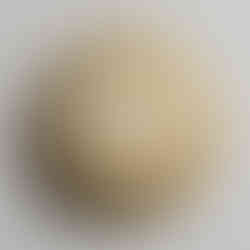北朝筆記 vol.23 大都會博物館:六朝黃釉模印花卉獅子野獸盤 - Met Museum, Six Dynasties Glazed Moulded Lion Dish
- SACA
- Feb 8
- 5 min read

六朝(公元220-589年)時期,中國的藝術發展呈現出多元化的特徵,受到了外來文化的強烈影響。特別是在北朝時期,隨著絲綢之路的開通,來自中亞和西方的文化傳播促使中國工藝技術和美學出現了顯著的變化。六朝黃釉模印花卉獅子野獸盤便是這一時期的重要代表之一,反映了西方金銀器工藝,尤其是薩桑王朝(公元224-651年)的金銀器對中國陶瓷的深遠影響。
這件獅子野獸盤的設計細緻入微,圖案呈現出對西方金屬工藝的強烈借鑑。盤面上,獅子呈攤開四肢的姿態,回首凝視,並伴隨著圓形珍珠裝飾與翻捲的葉片,這些細節直接呼應了當時薩桑王朝金屬器上的花紋。獅子形象和野獸圖案,這類西方風格的造型,象徵了力量與權威,在六朝的陶瓷藝術中也具有重要的象徵意義。這種模印技法和印花裝飾,顯示出中國陶瓷工匠對精緻與奢華的追求,並將外來藝術的影響內化,融入到中國本土的工藝傳統中。
此外,盤底的蓮花瓣造型和葉片的環繞,與中國傳統的宗教符號與自然觀察密切相關,這些細節展示了六朝時期中國藝術家對自然界形態的細緻觀察與詮釋。這些圖案不僅具有美學價值,還體現了當時社會對神聖、自然與權力象徵的崇拜。
這件器物的誕生和流傳,不僅是中西文化交匯的見證,更是南北朝時期粟特文化與中國陶瓷工藝深度融合的象徵。粟特商人作為絲綢之路上的重要商貿中介,將來自薩桑王朝的金銀器和西方工藝技術帶入中國,進而促進了中國陶瓷的革新與發展。

六朝黃釉模印花卉獅子野獸盤
大都會博物館藏
時期:六朝,晚期北朝(557–581)
文化:中國
材質:石器,帶有浮雕和壓印裝飾,施青瓷釉(北方器物)
尺寸:高 1 1/2 英寸(3.8 厘米);直徑 5 1/8 英寸(13 厘米)
分類:陶瓷
收藏來源:購自 Stanley Herzman 捐贈,1998年
物品編號:1998.335
展覽歷史:[Blitz 中國陶瓷與藝術品,荷蘭阿姆斯特丹,直到1998年;後售予大都會博物館]
香港松隱閣 Lam's Gallery 2024年曾展出一例類似作品,來自K.Y.Fine Arts繼遠美術的舊藏:
松隱閣 Lam's Gallery / 青瓷蓮心紋砵 南朝 d. 21 cm
Thickly potted with a narrow groove below the rim, the interior with a central medallion incised with a Lotus Bud, covered overall with a finely crackled lustrous yellowish-olive glaze stopping above the base, fitted box.
Compare a Southern dynasties Hongzhou celadon-glazed ‘Lotus Bud’ bowl, where the style of the incised decoration on the exterior is similar to the present lot, see Quan Kuishan, Shuo Tao Lun Ci: Quan Kuishan Taoci Kaogu Lunwen ji, Beijing, 2014, p.169, fig.2.
造型典雅,器身堅實,口沿處設計弦紋,內壁中央有刻划精美的蓮花心的圖案,與優雅的器型結合,如一朵含苞待放的蓮花,通體施細碎光澤的黃橘色釉,外壁流釉自然,層次鮮明靈動,底足特設凹陷弦紋設計,常見於器物內壁或碗底的北朝紋樣設計,被巧妙運用於底部,其巧思令人讚嘆。
參考一件南朝洪州窯蓮心紋杯,其紋飾與本器類比,見權奎山,《說陶論瓷:權奎山陶瓷考古論文集》,北京,2014年,頁169,圖2。
點擊:觀看松心閣展覽
FAQ 六朝黃釉器
1. 這件六朝黃釉模印花卉獅子野獸盤有何特點? 這件盤子以其精緻的模印和花卉、獅子野獸的圖案而著名。獅子圖案以其四肢攤開的姿態與回首的頭部,呈現出西方金屬工藝的影響。盤子上的圓形珍珠裝飾和蓮花瓣形狀也反映了六朝時期的裝飾風格。
2. 這件器物的藝術價值是什麼? 這件器物展示了當時中西文化交融的藝術特徵。它是六朝時期中國陶瓷工藝與薩桑王朝金銀器工藝相互影響的具體體現,顯示了中國工匠在模印技術和裝飾藝術方面的創新。
3. 六朝黃釉模印花卉獅子野獸盤的歷史背景是什麼? 六朝時期的藝術受到來自西方的薩桑王朝金銀器的影響,特別是在雕刻、圖案設計以及裝飾手法上。這件器物的設計反映了絲綢之路上粟特文化與中國的融合。
4. 這件器物的材料和工藝是什麼? 這件器物由石器製成,並在表面上施以黃釉,采用模印技法進行花卉和動物圖案的裝飾。
5. 如何理解六朝黃釉模印花卉獅子野獸盤中的西方元素? 這些西方元素體現在獅子的圖案設計和圓形珍珠、葉片的裝飾上,這些圖案與薩桑王朝金屬器上的風格十分相似,顯示出兩者之間的文化交流。

Six Dynasties Glazed Moulded Lion Dish
The crisply rendered feline sprawled in spread-eagle position with head regardant, the ring of pearl beading, the design of scrolling leaves alternating with outstretched animals, the wreathlike motif, and the band of concave radiating lotus petals on this celadon dish all demonstrate the very strong influence of Western metalwork on Chinese ceramics in the sixth century.
Title: Dish
Period: Six Dynasties, late Northern Dynasties (557–581)
Culture: China
Medium: Stoneware with relief and impressed decoration under celadon glaze (Northern ware)
Dimensions: H. 1 1/2 in. (3.8 cm); Diam. 5 1/8 in. (13 cm)
Classification: Ceramics
Credit Line: Purchase, Stanley Herzman Gift, 1998
Object Number: 1998.335
[ Blitz Chinese Ceramics and Works of Art , Amsterdam, NL, until 1998; sold to MMA]
The Six Dynasties period (220-589 CE) marked a significant era in Chinese art, characterized by the interplay of local traditions and foreign influences. The example of the Six Dynasties Glazed Moulded Lion Dish is a testament to the profound impact of Western metalwork, particularly from the Sassanian Empire (224-651 CE), on Chinese ceramics. The intricate lion motif on the dish, presented in a sprawling position with a head turned back, along with pearl beading and scrolling leaf designs, exemplifies the blending of Western metalwork aesthetics with Chinese ceramic techniques.
The use of moulded and impressed decoration under a celadon glaze reflects the high craftsmanship of Northern ware from this period. The Sassanian influence is particularly evident in the use of animal and floral patterns, which were common in Sassanian silver and goldwork. These elements were brought to China through the Sogdian merchants, who played a vital role in facilitating cultural exchanges along the Silk Road during the Northern and Southern Dynasties.
This dish serves as a symbol of the deep cultural exchange between the East and West, showcasing how foreign influences were absorbed and reinterpreted in Chinese art, particularly in the realm of ceramics. The intricate patterns and symbolism of power, nature, and the divine are characteristic of the era's artistic values and the socio-political environment.
























Comments